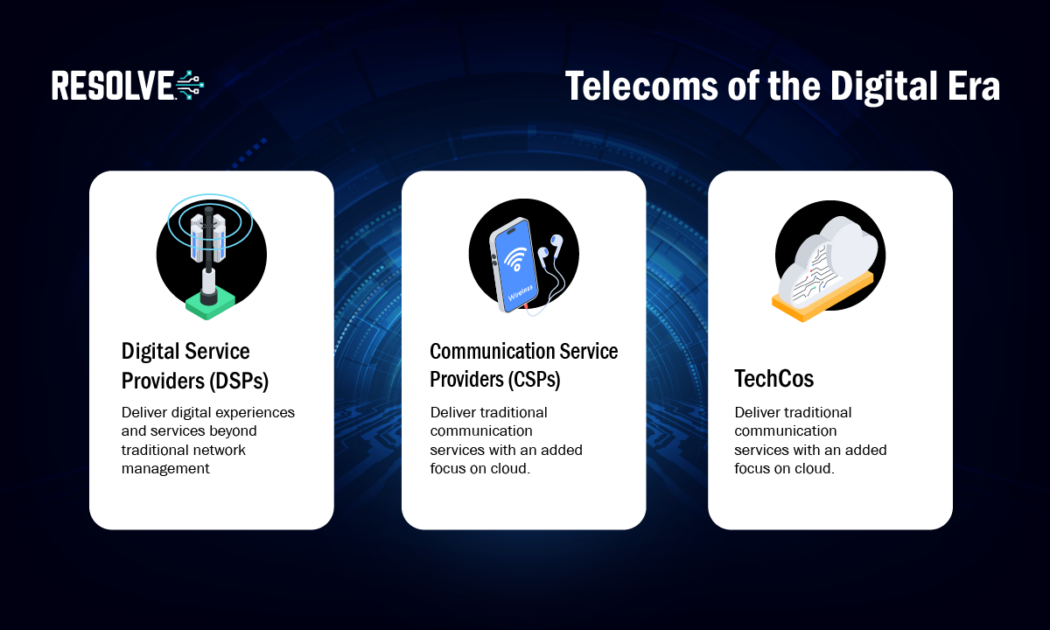
Network Automation for Telecoms: Securing the Future with Efficient and Scalable Network Management
Subscribe to receive the latest content and invites to your inbox.
Terms like digital service provider (DSP), communications service provider (CSP), and technology company (TechCo) are reshaping how the industry approaches service delivery.
As customer needs grow and network complexities increase, network automation is central to meeting telecom's demands.
In this conversation, we will explore network automation's drivers, the telecom sector's changing classifications, and how automation aligns with the industry's goals for scalability, efficiency, and customer satisfaction.
Telecoms Unpacked: Understanding the Key Players and Services
In telecom, new acronyms like DSP and CSP aren't just jargon—they reflect an industry that's rapidly evolving to keep up with digital demand.

So, what do they all mean, and why is network automation at the heart of it?
1. Digital Service Providers (DSPs)
DSPs are telecom companies focused on delivering digital experiences and services beyond traditional network management. They're involved in providing digital products like streaming services, cloud storage, and internet-of-things (IoT) solutions. DSPs are heavily reliant on automation to manage vast amounts of data, ensure high service quality, and respond to real-time user needs.
2. Communications Service Providers (CSPs)
CSPs deliver traditional communication services such as voice calling, messaging, and data, but they're also expanding into digital services. For CSPs, network automation is a means to maintain network reliability while also adapting to the demands of a broader service portfolio, often through technologies like software-defined networking (SDN) and network functions virtualization (NFV).
3. Technology Telecom Companies (TechCCos)
Some telecom firms have rebranded as TechCos, emphasizing technological innovation and convergence with IT services. TechCos leverage network automation to drive innovation and experiment with new services without disrupting core operations. This classification often overlaps with investing heavily in AI-driven automation, cloud computing, and edge networking.
The Need for Telecom Network Automation
Shifting customer needs and technological advances are the main driving forces for network automation.
The rapid growth in demand for high-speed connectivity, reliable service, and innovative digital products has dramatically shifted customer expectations. As a result, telecom providers face new and different challenges:
- High Network Availability: Customers expect uninterrupted connectivity, especially with the rise of 5G and IoT applications.
- Quick Incident Resolution: Downtime directly impacts customer experience and satisfaction. Automated systems are expected to monitor and resolve issues rapidly.
- Scalability and Agility: Telecom networks are more dynamic than ever, requiring quick scaling to meet fluctuating demands, especially in times of peak usage or emergencies.
- Cost Efficiency: Reducing operational expenses is crucial, given the high cost of network maintenance and expansion.
Telecom leaders know that evolving customer expectations are a major driver behind these new categories. With customers now expecting ultra-fast internet, uninterrupted streaming, and instant service personalization, the demand for more agile, efficient networks is at an all-time high.
Networks that can scale and self-heal are essential for telecom companies to respond effectively—these comprise the exact kind of adaptability that only automation can deliver.
Telecom Goals in a Digital-First World
Given these shifts in customer needs, telecom's goals have evolved as well.
Network automation helps traditional telecom providers push toward DSP, CSP, and TechCo capabilities and achieve several core goals:
- Enhancing Customer Satisfaction: Minimizing disruptions is a significant factor in customer retention.
- Scaling Infrastructure on Demand: Deploying resources dynamically to meet user expectations.
- Streamlining Network Management: Lower operational expenses and efficiently maintain existing networks for optimal performance.
- Boosting Innovation Capacity: Integrate emerging technologies, improve service quality, and provide better customer experiences.
Network Automation's Role in Meeting Telecom Goals
Telecom network automation addresses critical telecom goals and provides a foundation for modern network management.
Improving Network Reliability and Availability
Through automated monitoring and incident response, telecom network automation enables telecoms to keep network issues at bay. For instance, AI for IT Operations (AIOps) platforms provide real-time monitoring and predictive insights, allowing providers to address potential issues before they escalate. Proactive measures prevent network outages and enhance service quality, which is especially critical for DSPs and CSPs focused on customer-centric services.
Enhancing Scalability and Flexibility
The ability to automate capacity scaling is essential for responding to variable network demands. Automation tools like software-defined wide area network (SD-WAN) allow telecoms to scale bandwidth or efficiently allocate resources based on usage patterns. This flexibility is vital for TechCos and DSPs that manage not only communication services, but also digital product offerings that rely on seamless connectivity.
Reducing Operational Costs and Increasing Efficiency
Telecom network automation reduces labor costs by minimizing repetitive tasks such as configuration, monitoring, and troubleshooting. By automating these tasks, telecom companies cut down on human error and reduce the need for manual interventions. Additionally, automation improves overall operational efficiency, allowing for quicker resolution times and enabling teams to focus on strategic initiatives.
Accelerating Innovation with Event-Driven Automation
For telecoms, real-time response to network events is crucial for effective management and service delivery. With event-driven automation, networks can dynamically adjust to real-time demands such as handling security events, adjusting for workload shifts, or addressing network incidents as they arise. This form of automation closely aligns with the goals of DSPs, which rely on constant uptime and adaptability to offer digital services at scale.
Key Technologies Supporting Telecom Network Automation
To achieve these goals, telecoms deploy an array of automation technologies that support their transformation to DSPs, CSPs, and TechCos:
- AIOps: Using artificial intelligence (AI) to analyze vast amounts of network data, AIOps platforms support predictive maintenance, proactive problem resolution, and intelligent incident management.
- SDN and NFV: These technologies enable network virtualization and software-defined control, making network resources more flexible, programmable, and efficient.
- Orchestration and Low-Code Automation Platforms: Platforms offering low-code interfaces allow for fast deployment of automated workflows, making telecom network automation accessible to teams without heavy coding knowledge.
Telecom Network Automation is Here to Stay
With network demands growing exponentially, telecom network automation is no longer optional. Here's why it remains critical:
- Efficiency Gains: Automation significantly reduces the time spent on routine maintenance tasks, allowing telecoms to focus on high-value projects.
- Improved Customer Satisfaction: A more reliable network leads to happier customers and strengthens brand loyalty.
- Scalability for 5G and IoT: As devices multiply and data demand rises, automation allows Telecoms to handle the increased workload without sacrificing service quality.
- Competitive Advantage: In a market that includes both traditional Telecoms and tech giants, automation gives Telecoms the agility to innovate quickly and stay competitive.
Making Network Automation a Priority: Next Steps
Telecom network automation is transforming the industry, enabling telcos to address complex challenges, respond to dynamic customer demands, and expand service offerings in a competitive market.
Automation represents an opportunity for DSPs, CSPs, and TechCos to future-proof their networks, drive efficiencies, and offer high-quality services that meet the needs of the digital age.
As we look to the future, automation's role in telecommunications will only grow, making it an essential strategy for every telecom sector player.
Request a demo to learn how we can help you stay ahead in the telecom network automation game.






